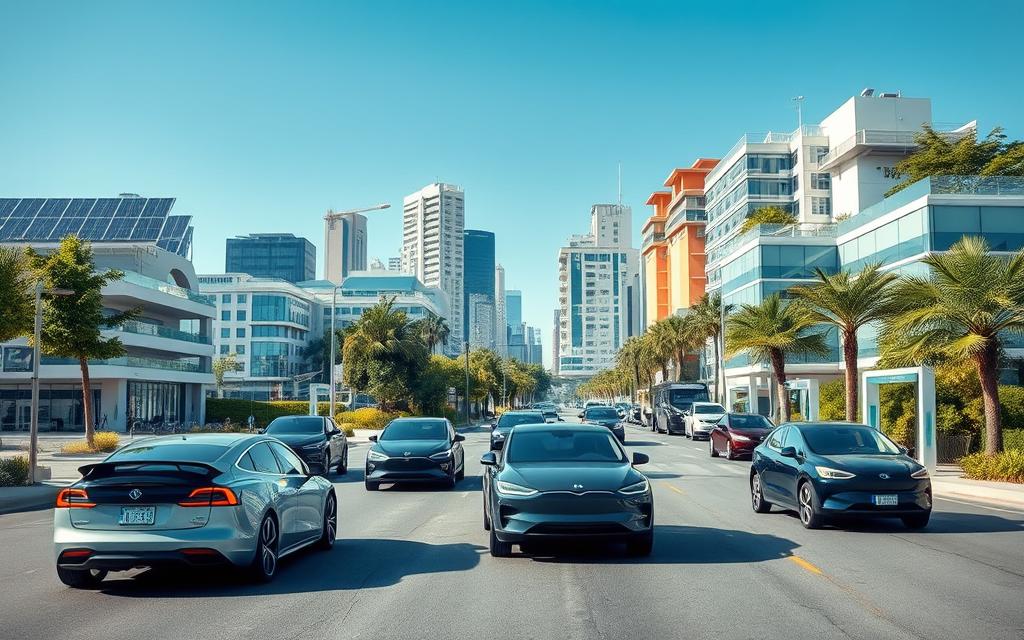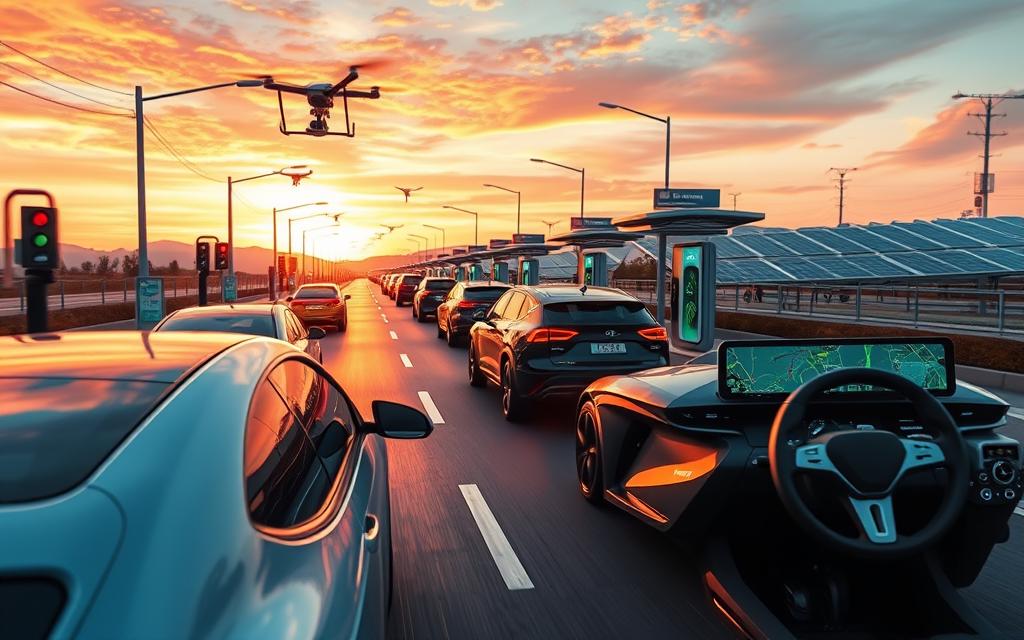What Is Automotive Technology and How Does It Drive Innovation?
Automotive technology is leading the way in transforming transport. It includes a wide variety of innovations that improve vehicle design and function. These days, cars are much more than just a way to get around. They offer improved comfort, safety, and efficiency.
The car industry is putting a lot of money into research and development. This work is to make better and more sustainable ways to travel. Innovations like electrification and advanced safety features are making roads safer and more eco-friendly. To learn more about these changes, click here. These new developments are all about meeting consumer needs and leading the way in transport innovation.
The Evolution of Automotive Technology
The story of car tech is fascinating, filled with big steps forward in innovation. It started in the late 1800s, turning early ideas into today’s advanced vehicle technologies. The roots of this field go back to the 19th century, forming the base of modern car design.
From Early Innovations to Modern Advancements
In 1885, Karl Benz introduced the first car running on petrol. This significant creation used an internal combustion engine, marking the start of a new era in getting around. Soon after, Henry Ford changed manufacturing with his assembly line method, making cars cheaper for everyone. This change led to more people owning cars and changed how we move.
By the mid-20th century, we saw major steps in making cars safer, like inventing the three-point seatbelt and the first airbag for passengers. In the 1980s, cars began to get ECUs to make them run better, showing a move towards more complex tech.
Key Milestones in Automotive History
- 1898: Ferdinand Porsche designs the first hybrid car, leading to new electric car tech.
- 1908: Ford’s Model T brings petrol cars to more people through mass production.
- 1939: Cars now have turn signals, making roads safer.
- 1973: Oldsmobile’s introduction of the passenger airbag is a big step forward in car safety.
- 1980s: Cars move from carburetors to electronic fuel injection, improving how they perform.
- 1998: The rule for dual frontal airbags makes cars safer for everyone.
Looking ahead, car tech will keep evolving with AI, 5G, and the Internet of Things shaping its future. Today, the focus isn’t just on better performance. It’s also about improving safety, efficiency, and how we interact with cars. This marks an important period in the story of car tech.
What Does Automotive Technology Do?
Automotive technology is changing cars for the better. It focuses on safety and making cars work better and go farther. These changes not only keep drivers and passengers safe. They also help our planet by being more gentle on it.
Enhancing Safety Features
Car safety has come a long way recently. Now we have things like adaptive cruise control and automatic brakes. These smart features fix mistakes people make while driving. They make the roads safer for everyone by reacting fast to dangers.
Most car accidents happen because of human mistakes, about 97% of them. So, it’s crucial to use technology to prevent these accidents. Advanced safety tech is key.
Improving Efficiency and Performance
Cars are using less fuel these days, thanks to new engine tech and lighter materials. This is good because it means cars perform better and don’t harm the environment as much. Car technology now focuses on keeping an eye on how the car is running. It helps cars work at their best and use less fuel.
| Safety Feature | Description | Benefit |
|---|---|---|
| Adaptive Cruise Control | Automatically adjusts vehicle speed to maintain a safe distance from the car ahead. | Reduces the risk of rear-end collisions. |
| Automatic Emergency Braking | Recognises potential crash situations and applies brakes to prevent accidents. | Minimises the impact of frontal collisions. |
| Electronic Stability Control | Helps drivers maintain control during skids or sudden turns. | Enhances vehicle stability and reduces rollover risk. |
Automotive technology keeps getting better, making driving safer and cars more efficient. As it evolves, the goal is to merge safety with performance. It’s shaping how we’ll travel in the future.
The Rise of Electric Vehicles (EVs)
The move to electric vehicles signifies a big change in how we travel. It starts a new era of eco-friendly journeys. People and governments are looking for greener options. This has made electric cars more popular, helped by laws that support this change.
Transition to Electric Mobility
The switch to electric cars is happening because people are more welcoming of them. Also, there are better ways to charge these cars now. In the U.S., experts think electric car sales will go up by 20% in 2024. Worldwide, we might see a 29% increase. Already, 31 countries have more than 5% of cars electric, showing a big shift.
Car companies are seriously getting into electric vehicles. Brands like Ford and General Motors are investing in electric car technology. They’re also making sure they have enough materials like lithium for batteries. The U.S. government is putting $7.5 billion into more electric car chargers. They want 500,000 new chargers by 2030 to help more people choose electric cars.
Future Trends in EV Adoption
The future looks bright for electric cars. By 2025, about 30% of all new cars could be electric or hybrids. This is part of moving towards more sustainable transport options. Electric engines are also more efficient. They use battery power better than old engines, cutting down waste and fighting climate change.
Electric vehicle technology is always getting better. Car makers, tech companies, and scientists are working together. They’re finding new ways to make electric vehicles even more appealing.
| Key Statistics | United States | Global |
|---|---|---|
| Projected increase in EV sales (2024) | 20% | 29% |
| Countries exceeding 5% EV adoption | 31 | N/A |
| Estimated EV market share by 2025 | N/A | 30% |
| Bipartisan Infrastructure Law funding for EV charging | $7.5 billion | N/A |
| Projected EVs on U.S. roads by 2030 | 26.4 million | N/A |

Autonomous Vehicles and Their Impact
The move towards autonomous vehicles is set to change how we get around and improve transportation across the globe. These smart vehicles don’t need a person to control them. They use advanced tech like sensors and machine learning to understand their environment. This helps them make decisions in real-time, increasing safety and making travel more efficient.
Understanding Self-Driving Technology
Self-driving cars use sensors such as radar, cameras, and LiDar to gather information. This data is then analysed to make decisions, like when to stop or turn. There are six levels of self-driving, according to the Society of Automotive Engineers. As we move towards fully self-driving cars, we could see fewer car crashes. Studies show that human errors cause most accidents. Features in today’s cars, known as ADAS, are already making roads safer.
Benefits of Vehicle Automation
There are many benefits to self-driving cars. These include less traffic and fewer accidents. Indeed, vehicle automation could cut down traffic delays on highways by 60%. They are also better for the planet. A study says they could reduce harmful emissions by 9%. And, they could make it easier for disabled and older people to get around.
Looking to the future, self-driving technology could also create new business opportunities. By 2035, McKinsey suggests this could add $300 to $400 billion to the car market. The growth of autonomous vehicles is a big deal. It meets urban goals for reducing noise, pollution, and reliance on owning cars. Plus, it could transform how we commute and live. Click here to learn more about automation benefits.
Connected Cars: The Future of Automotive Technology
Connected cars are changing car technology, letting vehicles talk with each other and the world around them. This big change is making cars safer and traffic flow better, thanks to Vehicle-to-Everything (V2X) communication.
Vehicle-to-Everything (V2X) Communication
V2X lets cars, roads, and even people share information. This helps cars move smoothly and reduces crashes. With upcoming 5G networks, cars will get traffic and road condition updates faster. More and more new cars use V2V tech, and this is expected to increase. This technology also encourages driving that’s better for the planet. It helps drivers use less fuel and cut down on emissions.
Data Security and Consumer Privacy Concerns
However, connected cars come with challenges, like the risk of cyber attacks. As cars connect more, they become targets for hackers. There’s been a rise in data breaches, stressing the need for strong cybersecurity. Car makers are working hard to make cars safer online, but keeping data private is still important. Many people worry about how much data cars collect. Finding a balance between the benefits of connected cars and protecting privacy is key for the future.
Conclusion
The car sector is at a crucial turning point because of fast tech growth. It’s changing how vehicles work and reshaping our travel experiences. By 2030, we expect to see a big jump in electric and hybrid cars on the road, from 3 million in 2017 to 125 million. This shift is making our journey towards sustainable transport faster.
New tech like self-driving cars, advanced driver help, and vehicle connectivity are changing the car world. There’s a higher need for skilled workers who can deal with the new and complex car tech. New materials, digital communication in cars, and the use of 3D printing show that specific training is more important than ever.
Even with concerns about safety, privacy, and rules, the future looks bright with better mobility and fewer emissions. The changes in car tech are in line with societal changes. They prepare us for new ways to meet our travel needs. Staying updated with these techs is key to keeping roads safe and looking after our planet.
FAQ
What is automotive technology?
Automotive technology involves new innovations and advanced machinery in vehicle design and function. It aims to improve comfort, safety, and efficiency.
How has automotive technology evolved over the years?
From steam-powered cars of the late 19th century to today’s electric and autonomous vehicles, automotive technology has greatly advanced. It has improved in terms of safety, performance, and eco-friendliness.
What are some key milestones in the history of automotive technology?
Key milestones feature Karl Benz’s first petrol car in 1885 and Henry Ford’s assembly line. Also, digital systems and modern in-car entertainment have become common.
What automotive safety features are now standard?
Today’s cars have safety features like adaptive cruise control, emergency brakes, stability control, seatbelts, and airbags. These reduce accident risks.
How do advancements in automotive technology improve vehicle efficiency?
Better engine technology, lighter materials, and fuel-efficient designs boost performance. They lessen environmental harm, answering the call for greener transport.
What is driving the rise of electric vehicles (EVs)?
The growth in electric cars comes from tech improvements, higher consumer interest, laws supporting green transport, and financial benefits for choosing EVs.
What are the anticipated future trends in EV adoption?
By 2025, electric cars might make up about 45% of vehicles in Europe. This is thanks to better EV infrastructure and incentives for buyers.
What role do autonomous vehicles play in modern transportation?
Driverless cars use AI and sensors to better personal travel. They could lower accidents, manage traffic well, and help those with disabilities get around easier.
How do connected cars function and what benefits do they offer?
Connected cars talk to each other and to roads using V2X tech. This makes travel safer and smoother, forming an advanced transport network.
What are the primary concerns regarding data security in connected vehicles?
With more connected cars, keeping data safe and private is key. Car makers are adding tough cyber security to safeguard user info and keep the benefits of being connected safe.















